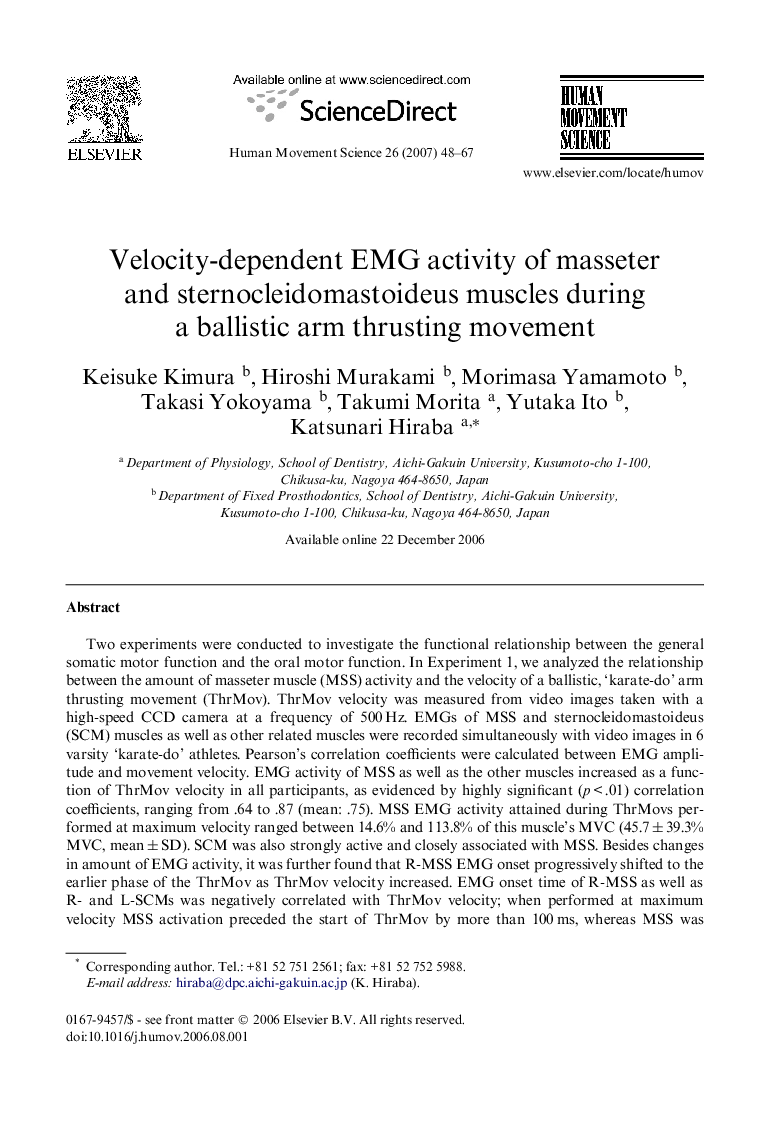| Article ID | Journal | Published Year | Pages | File Type |
|---|---|---|---|---|
| 928865 | Human Movement Science | 2007 | 20 Pages |
Two experiments were conducted to investigate the functional relationship between the general somatic motor function and the oral motor function. In Experiment 1, we analyzed the relationship between the amount of masseter muscle (MSS) activity and the velocity of a ballistic, ‘karate-do’ arm thrusting movement (ThrMov). ThrMov velocity was measured from video images taken with a high-speed CCD camera at a frequency of 500 Hz. EMGs of MSS and sternocleidomastoideus (SCM) muscles as well as other related muscles were recorded simultaneously with video images in 6 varsity ‘karate-do’ athletes. Pearson’s correlation coefficients were calculated between EMG amplitude and movement velocity. EMG activity of MSS as well as the other muscles increased as a function of ThrMov velocity in all participants, as evidenced by highly significant (p < .01) correlation coefficients, ranging from .64 to .87 (mean: .75). MSS EMG activity attained during ThrMovs performed at maximum velocity ranged between 14.6% and 113.8% of this muscle’s MVC (45.7 ± 39.3% MVC, mean ± SD). SCM was also strongly active and closely associated with MSS. Besides changes in amount of EMG activity, it was further found that R-MSS EMG onset progressively shifted to the earlier phase of the ThrMov as ThrMov velocity increased. EMG onset time of R-MSS as well as R- and L-SCMs was negatively correlated with ThrMov velocity; when performed at maximum velocity MSS activation preceded the start of ThrMov by more than 100 ms, whereas MSS was recruited last at ∼150 ms after the start of ThrMov when performed at moderate speed (∼50% of maximum). In Experiment 2, the effects of head movement relative to the trunk on R-MSS and SCMs EMG activity were tested in both gazing and sidelong glancing conditions. A much smaller head rotation relative to the trunk was necessary during the ThrMov in the sidelong glancing condition compared to the gazing condition. R-MSS EMG activity was affected significantly by the difference between these conditions and decreased by 5.2% MVC in the sidelong glancing condition compared to the gazing condition. In association with the change in requirement for head movement between those conditions, EMG balance between the bilateral SCMs changed substantially. Finally, marked muscle activity during ThrMov was found in the MSS that was not directly involved in performing this movement, indicating a form of ‘remote facilitation’.
